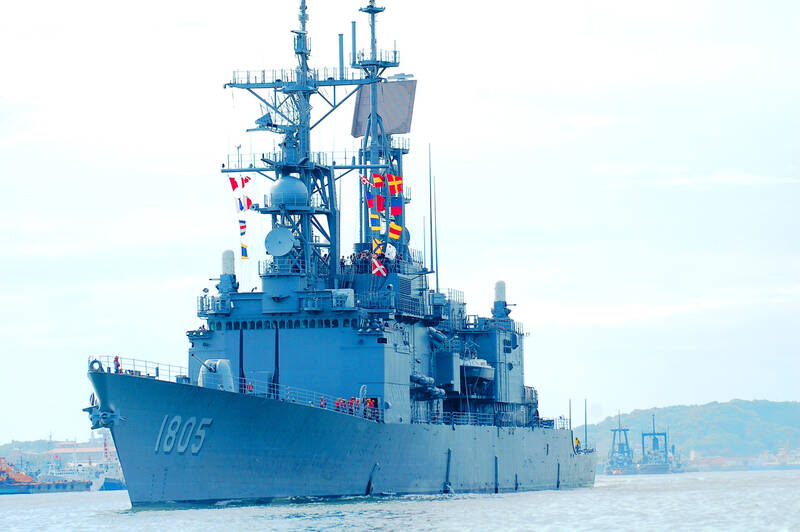The Ministry of National Defense on Saturday declined to comment on the authenticity of an audio recording of an apparent confrontation between a Taiwanese navy vessel and a Chinese navy destroyer off eastern Taiwan.
In the recording, a person, allegedly an officer on the Chinese destroyer Xiamen, can be heard saying that there is no border of Taiwan’s contiguous zone during a radio exchange with the guided-missile destroyer ROCS Ma Kong.
The recording, posted on social media, was allegedly made by the Marshall Islands-flagged bulk carrier Lady Neeti, which was sailing nearby when the exchange took place.

Photo: Huang Liang-chieh, Taipei Times
In the recording, a man’s voice can be heard identifying his vessel as the Ma Kong and warning another ship that it is approaching the outer edge of the nation’s contiguous zone, 44.5km from the baseline.
Another man’s voice replies: “Xiamen to Ma Kong, the so-called ‘24 nautical-mile [44.5km] baseline’ does not exist. Please check your terminology. Our ship has the right to sail here. Please maintain a safe distance of at least 3 nautical miles.”
“This is Ma Kong. We are currently sailing on a course of 230°. Please adjust your course as appropriate,” the first voice is heard as saying, to which the second voice replies: “Xiamen copies.”
The ministry declined to go into details about its military deployments, saying only that it had taken appropriate response measures to all incursions by Chinese military vessels.
Institute for National Defense and Security Research analyst Su Tzu-yun (蘇紫雲) said the best way to prepare Taiwanese mentally for Chinese military incursions is to make information about the incursions more transparent and accessible.
Since US House of Representatives Speaker Nancy Pelosi’s visit to Taiwan in early August, Chinese warships have routinely carried out incursions past the median line of the Taiwan Strait and sailed in the waters off Taiwan’s east coast in an attempt to create a new “status quo,” Su said.
Taiwan could learn from Japan’s model of issuing alerts whenever North Korea fires missiles toward it, he added.
Separately, the ministry said 10 Chinese fighter jets crossed the median line on Saturday.
They were among 36 Chinese aircraft detected near Taiwan that day, the ministry said, adding that three Chinese naval vessels had also been spotted in the area.
The ministry said that six Shenyang J-11 and four J-16 planes flew across the median line.
The military also spotted four Chengdu J-10 fighter jets, a Y-8 anti-submarine warfare plane, and three H-6 strategic bombers in Taiwan’s southwestern air defense identification zone, the ministry said.
In addition, three Chinese uncrewed aerial vehicles — a Harbin BZK-005 high-altitude, long-range drone, a Guizhou BZK-007 and a CASC Rainbow CH-4 — were detected in the same area, it said.
The ministry said it scrambled combat air and naval patrols, and deployed defense missile systems to track the Chinese aircraft.

The disruption of 941 flights in and out of Taiwan due to China’s large-scale military exercises was no accident, but rather the result of a “quasi-blockade” used to simulate creating the air and sea routes needed for an amphibious landing, a military expert said. The disruptions occurred on Tuesday and lasted about 10 hours as China conducted live-fire drills in the Taiwan Strait. The Civil Aviation Administration (CAA) said the exercises affected 857 international flights and 84 domestic flights, affecting more than 100,000 travelers. Su Tzu-yun (蘇紫雲), a research fellow at the government-sponsored Institute for National Defense and Security Research, said the air

Taiwan is to commence mass production of the Tien Kung (天弓, “Sky Bow”) III, IV and V missiles by the second quarter of this year if the legislature approves the government’s NT$1.25 trillion (US$39.78 billion) special defense budget, an official said yesterday. Commenting on condition of anonymity, a defense official with knowledge of the matter said that the advanced systems are expected to provide crucial capabilities against ballistic and cruise missiles for the proposed “T-Dome,” an advanced, multi-layered air defense network. The Tien Kung III is an air defense missile with a maximum interception altitude of 35km. The Tien Kung IV and V

Trips for more than 100,000 international and domestic air travelers could be disrupted as China launches a military exercise around Taiwan today, Taiwan’s Civil Aviation Administration (CAA) said yesterday. The exercise could affect nearly 900 flights scheduled to enter the Taipei Flight Information Region (FIR) during the exercise window, it added. A notice issued by the Chinese Civil Aviation Administration showed there would be seven temporary zones around the Taiwan Strait which would be used for live-fire exercises, lasting from 8am to 6pm today. All aircraft are prohibited from entering during exercise, it says. Taipei FIR has 14 international air routes and

Taiwan lacks effective and cost-efficient armaments to intercept rockets, making the planned “T-Dome” interception system necessary, two experts said on Tuesday. The concerns were raised after China’s military fired two waves of rockets during live-fire drills around Taiwan on Tuesday, part of two-day exercises code-named “Justice Mission 2025.” The first wave involved 17 rockets launched at 9am from Pingtan in China’s Fujian Province, according to Lieutenant General Hsieh Jih-sheng (謝日升) of the Office of the Deputy Chief of the General Staff for Intelligence at the Ministry of National Defense. Those rockets landed 70 nautical miles (129.6km) northeast of Keelung without flying over Taiwan,